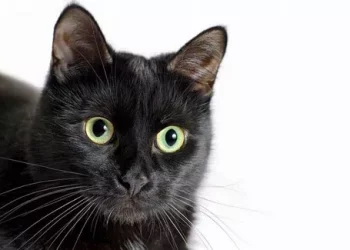Bombay cats are a popular breed of domestic cats known for their shiny black coats and golden eyes. They are a cross between Burmese and American Shorthair cats, and they are highly sought after for their affectionate nature and playful personality. While the standard Bombay cat is a solid black color, it is not uncommon for some individuals to have white patches on their coat. In this article, we will explore the phenomenon of Bombay cats with white patches and try to understand its causes and implications.
Firstly, it is important to note that the Bombay cat breed standard specifies that the coat must be solid black with no other colors or markings allowed. However, as with all living creatures, genetic variations can occur, and some Bombay cats may have white patches on their coat. These patches can range in size and location and can be anywhere from small spots to large patches that cover a significant portion of the cat’s body.
There are several possible reasons why a Bombay cat might have white patches on its coat. One possibility is that it is the result of a genetic mutation. The gene responsible for the black coat color in Bombay cats is called the “extension” gene, and it controls the production of melanin, the pigment that gives color to the hair, skin, and eyes. A mutation in this gene can cause white patches to appear in the cat’s coat. This type of mutation is rare, but it is possible, and it can occur in any breed of cat.
Another possible explanation for white patches on a Bombay cat’s coat is that it is the result of crossbreeding. Bombay cats are a cross between Burmese and American Shorthair cats, and if either of these breeds had white patches in their ancestry, it is possible that the trait could be passed down to the offspring. This is especially likely if the cat’s lineage includes cats with Siamese or other pointed breeds, which are known for their color-pointed coats.
While some people may find Bombay cats with white patches to be visually appealing, it is important to note that these cats do not conform to the breed standard. This means that they cannot be shown in cat shows or used for breeding purposes, as their offspring may also have white patches or other coat variations that are not desirable in the breed. However, for those who are looking for a companion animal and are not concerned with showing or breeding, a Bombay cat with white patches can make a wonderful and loving pet.
In terms of health implications, having white patches on their coat does not necessarily indicate any health problems in Bombay cats. However, it is important to note that any cat with unusual coat variations or markings should be examined by a veterinarian to rule out any underlying health issues. Additionally, some cats with white patches may be more prone to sunburn, especially in areas with little hair cover, such as the nose, ears, and belly. As with any cat, it is important to provide proper care and protection to keep them healthy and happy.
In conclusion, while it is not common, Bombay cats can have white patches on their coat due to genetic mutations or crossbreeding. While these cats may not conform to the breed standard, they can still make wonderful pets for those who are looking for a loving and playful companion. As with any cat, it is important to provide proper care and attention to ensure their health and happiness, and to have them examined by a veterinarian if any unusual coat variations or markings are observed.

























